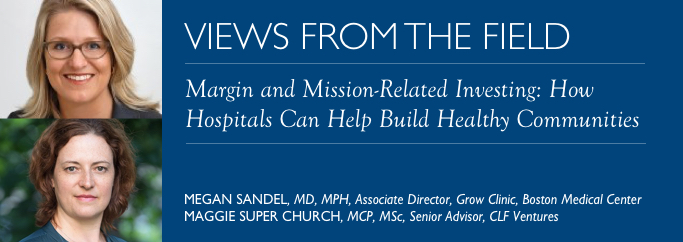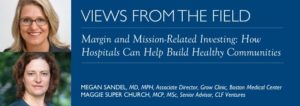
Hospitals play a critical role in advancing the health of communities beyond providing medical care or community benefit dollars. As anchor institutions, hospitals can drive place-based change and improve health outcomes through local hiring, procurement, and other efforts that address the social, economic, and environmental factors that shape health. A growing number of hospitals and health care systems are looking to build healthy neighborhoods through more targeted use of their investment capital. As more hospitals explore this model, there are growing opportunities to partner with philanthropy, community development financial institutions (CDFIs), and other sectors investing in the health of communities.
No Margin, No Mission
Hospitals, particularly those that serve low-income communities, often have a saying: “no margin, no mission.” While these institutions are committed to their “mission” of serving the underserved, regardless of ability to pay, these hospitals, like any other business, must have total revenues that exceed total costs in order to survive over the long term. Safety net hospitals in particular are generally not set up to make a huge profit, but must have some margin to meet their mission of providing care for the sickest and most vulnerable people in our communities. Often, this means focusing on providing the highest quality, lowest cost care to be effective.
At the same time, serving low-income people often means dealing with social determinants of health, like homelessness and housing instability, that drive up health care utilization and cost. In many communities, 1 percent of the population is responsible for 25 percent or more of the health care dollars spent, and a high proportion of these high-cost users are chronically homeless.
At Boston Medical Center, a recent survey showed 25 percent of patients admitted to the hospital were homeless. As payment reform shifts compensation from “volume” (where health systems are paid for each admission to the hospital) to “value” (where they are compensated to keep people from being admitted) hospitals and insurers have a strong incentive to find solutions for the prevention as well as treatment of disease. In this new era, health systems have a role to play as direct investors in the social determinants of health, including safe and affordable housing, healthy food, and stable employment, that keep people healthy to meet both “margin” and “mission.”
Housing and Community Development: a Delivery System for Health
The housing and community development sector is a natural place to deliver projects and services that address the social determinants of health, particularly housing, but is increasingly stretched thin with mounting unmet need and not enough capital. In Massachusetts, which dedicates comparatively more resources to affordable housing than most states, the number of state rental vouchers available to low-income families dropped from 20,000 in 1990 to 6,600 in 2014 (Johnston 2014).
At the federal level, the administration’s proposed 2018 budget would slash more than $6 billion in funding from the Department of Housing and Urban Development, including the elimination of the Community Development Block Grant program, HOME Investment Partnership program, Choice Neighborhoods program, and Self-help Homeownership Opportunity Program (DelReal, 2017). While the fate of these programs is not yet clear, there is no question that demand for these funds far outpaces supply.
A 2017 study by the National Low-Income Housing Coalition found that over 20 million renter households in the United States live in housing poverty, meaning they cannot afford to meet their other basic needs like food, transportation, medical care, and other goods and services after they pay for their housing (NLIHC 2017). In the face of this crisis, we see an opportunity to link up the health sector, which has capital and needs access to housing and services for its patients and workforce, with the housing and community development sector, which has the expertise to creating housing and community services and needs access to capital to help finance these projects.
While it is difficult to measure precisely how much investment capital is controlled by hospitals and health systems, the Democracy Collaborative has estimated that health care endowments amount to at least $500 billion nationally (Howard and Norris 2015). In addition to endowments, hospitals and health systems also control community benefit spending, payer and provider funds through Accountable Care Organizations, and insurance reserves. Impact investment funds and other financing vehicles that directly address the social determinants of health can provide a platform for hospitals to use these financial resources for Mission-Related Investments, or MRIs, which seek to achieve financial returns while also advancing mission (Walker 2017).
Margin and Mission: the Healthy Neighborhoods Equity Fund
The Healthy Neighborhoods Equity Fund (HNEF) is a groundbreaking example of impact investing that marries margin and mission in a marketable fund focused on social determinants of health in the built environment. HNEF is a private equity real estate fund investing in mixed-income housing, retail, and commercial space near public transportation (often referred to as Transit-Oriented Development, or TOD) in underserved neighborhoods where traditional investment capital is not available. The fund is sponsored by two regional organizations, the Massachusetts Housing Investment Corporation and the Conservation Law Foundation. HNEF has three classes of investors: state and federal agencies, who take the highest risk and receive no financial return, similar to grantmaking; philanthropic investors, including the Robert Wood Johnson Foundation, The Kresge Foundation, and the Boston Foundation, who take slightly less risk and receive a modest financial return; and private investors, including banks, high net worth individuals, and hospitals, which take the least risk and receive the highest financial return.
Since its inception, HNEF has closed five investments to finance projects in Boston, Chelsea, Braintree, and Beverly, for a total investment of $14.2 million. HNEF will soon close on another Boston project, bringing total investments to $17.7 million. These projects have leveraged an additional $121.5 million of private and public investment in low- and moderate- income neighborhoods. Together, they will create 528 new mixed-income housing units and over 106,000 square feet of commercial space and generate nearly 1,100 new construction jobs and over 140 new permanent jobs.
The Role of Boston Medical Center
One of the most exciting aspects of HNEF is the decision by Boston Medical Center (BMC) to participate as an institutional investor, motivated by the opportunity to meet the hospital’s requirements for both margin and mission. In addition to investing in the fund, BMC has also committed to providing a very low-cost loan to a new grocery store that will anchor an HNEF-financed project, allowing the store to provide much deeper discounts for low-income families. With this example as a starting point, we believe there is tremendous opportunity for hospitals and health systems to more intentionally align their resources and become both margin and mission-related investors in a range of projects that promote population health. These investments need to address all levels of prevention, taking care of the highest-cost users in the health care system while also addressing the pipeline of people getting sicker.
Conclusion
Hospitals can partner with foundations and the housing and community development sector to invest in healthy neighborhoods that address the social determinants of health and help to prevent disease altogether. As many funders explore nontraditional strategies such as impact investing to improve health outcomes, it will be essential to foster cross-sector collaboration with hospitals and health systems. By aligning efforts, hospitals, grantmakers, and other place-based investors can support healthy, equitable, and sustainable communities for all.
References
DelReal, Jose A. “Trump Budget Asks for 6 Billion in HUD Cuts, Drops Development Grants”. Washington Post. March 16, 2017.
Howard, Ted and Tyler Norris. “Can Hospitals Heal America’s Communities?” December, 2015.
Johnston, Katie. “Demand for Affordable Housing Soars in Boston Area”. Boston Globe. November 28, 2014.
National Low Income Housing Coalition. “Out of Reach 2017: The High Cost of Housing.” Washington, DC. 2017.
Walker, Darren. “Unleashing the Power of Endowments: The Next Great Challenge for Philanthropy”. April 5, 2017.

